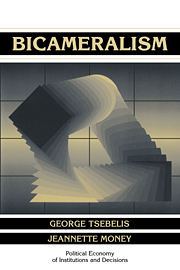Book contents
- Frontmatter
- Contents
- List of tables and figures
- Series editors' preface
- Acknowledgments
- Introduction
- PART I THE HISTORY AND GEOGRAPHY OF BICAMERAL DIVERSITY
- PART II MODELS OF BICAMERAL INSTITUTIONS
- Introduction to Part II
- 3 The core and the uncovered set of bicameral legislatures
- 4 A model of intercameral bargaining
- 5 A model of conference committees and their proposals
- PART III EMPIRICAL STUDIES OF BICAMERALISM AND IMPLICATIONS
- Conclusions
- References
- Index
5 - A model of conference committees and their proposals
Published online by Cambridge University Press: 02 December 2009
- Frontmatter
- Contents
- List of tables and figures
- Series editors' preface
- Acknowledgments
- Introduction
- PART I THE HISTORY AND GEOGRAPHY OF BICAMERAL DIVERSITY
- PART II MODELS OF BICAMERAL INSTITUTIONS
- Introduction to Part II
- 3 The core and the uncovered set of bicameral legislatures
- 4 A model of intercameral bargaining
- 5 A model of conference committees and their proposals
- PART III EMPIRICAL STUDIES OF BICAMERALISM AND IMPLICATIONS
- Conclusions
- References
- Index
Summary
As we discussed in Chapter 2, conference committees are frequently employed to reconcile intercameral differences. Conference committees are important because, in most cases, they are the last stage where legislative compromises are worked out and legislation is forged. The outcome of conference committee deliberations is then introduced to the parent chambers for approval under closed rule, that is, without possibility of amendment. Consequently, a strategic conference committee can select, from among all the proposals that the parent chambers prefer over the status quo, the one that is closest to its own preferences. The parent chambers may dislike one provision or another of the compromise bill, but they cannot alter the specifics; they can only reject the whole bill and start the legislative process again. Consequently, if a bicameral legislature resolves its differences through a conference committee, the compromise elaborated in this committee usually becomes the law.
In all countries where the institution exists, except for the United States, the committee is composed of an equal number of members from each chamber, and it decides as a unicameral institution. In the U.S., the size of the conference committee varies as does the number of delegates from each house. Decisions are made by the so-called unit rule, that is, by concurrent majorities of each chamber's delegation. In countries where committees decide as unicameral institutions, the decision-making rule is by majority, with the exception of Japan, which requires qualified majorities.
To analyze the U.S. conference committee, we refer the reader to Chapter 3, since the unit decision-making rule is the same as bicameral decisions. However, before proceeding, we point out one aspect of the unit rule that we will refer to subsequently.
- Type
- Chapter
- Information
- Bicameralism , pp. 110 - 122Publisher: Cambridge University PressPrint publication year: 1997

